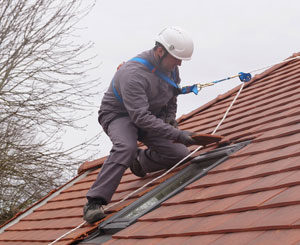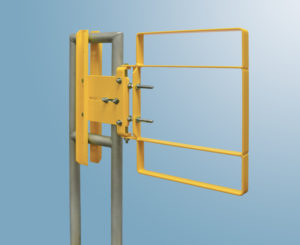
The National Safety Council announced OSHA’s Fall Protection – General Requirements (1926.501) as the most frequently cited violation in 2019, this being the ninth year in a row. This announcement comes as a challenge for safety managers and facility CEOs to improve their knowledge, training, and investment into indoor fall protection at the workplace. Since fall protection keeps coming up at the top of the list of workplace safety violations, it’s worth reviewing the basics to make sure your indoor fall protection systems are up to code.
Understanding OSHA’S Fall Protection General Standards
Safety for Ladders
OSHA’s guidelines under CFR 1910 stipulate that for fixed ladders extending over 24 feet from the lower levels, employers should provide a personal arrest system and a ladder safety system. The ladder safety system should be attached to the ladder to reduce the possibility of the worker falling off. The system is a combination of a carrier, a safety sleeve, connector, lanyard, and a body harness. OSHA also clarifies that cages around ladders are not safety systems.
To protect employees from falling into ladderway holes, employers should install a guard rail system and toeboards on all exposed sides. The entrances to the ladderway should have self-closing safety gates that swing or slide away from the hole and have a toprail and midrail equivalent to the surrounding guard rail system.
For temporary ladders, OSHA recommends that the ladders should be sturdy before employees use them and also have non-slip surfaces. Since this type of ladder is movable, a fall arrest system will have to be attached to a permanent surface.
Personal Fall Arrest System

The anchorage point should be sturdy enough to support both lifelines and lanyards. Usually, you will connect the body harness to a flexible lanyard and attach it to a lifeline. For maximum safety, all connectors, whether used for a harness, lifeline, lanyard or anchorage, should be steel-fabricated or other equally strong material. The connectors should also be corrosion resistant and smooth to prevent damage to connected surfaces.
The safety harness can be used together with positioning systems and travel restraint systems. This combination ensures that the worker is safe from falling and can still work freely on an elevated surface. Always check the safety harness for mildew, wear, damage, or deterioration before allowing a worker to use one. The workers should always wear the fall arrest harnesses with the attachment point at the center of the back near the shoulders.
Safety Gates & Guard Rails

Install the safety gates at the same level as the surrounding guard rail system. The top rail should be within 42 to 45 inches above the walking or working surface. The system could also include midrails, screens, meshes, and vertical members where no wall or parapet is at least 21 inches tall.
The guard rail system should be capable of resisting a force of at least 200 pounds applied directly to the top rail in an outward or downward direction. Lastly, the OSHA guidelines also recommend that all toprails should be kept smooth to prevent injuries or damage to clothes.
Training Your Workforce
Analyzing your employee’s training level will ensure that you prepare adequately for their next training session. There are four levels of training:
- Awareness-level training: This training consists of a general overview of fall hazards and fall equipment the workers may be exposed to on-site. Though it does not include hands-on verification training, it is just as important.
- Authorized-user training: This type of training is specific to the worker’s role. Any worker exposed to fall hazards should receive hands-on training and learn how to use the equipment.
- Competent-person training: This type of training delves into a variety of fall hazards and is vital for supervisors. A competent person requires advanced training because they need to understand the different types of fall hazards, equipment, and emergency measures to be taken after a fall. This type of training ensures that a supervisor can identify fall protection violations at the workplace and train employees.
- Qualified-person training: This is the highest level of training and typically requires degree programs and training to handle any fall hazard and protection equipment. When looking for the right person to guide your employees’ safety, find a person at this level.
After assessing your workforce and determining their training level, you should find a qualified vendor to provide training, should you need it. The trainer should be eligible to handle all levels of training, and preferably, take each worker through practical sessions to verify their understanding. Have some criteria for skills your employees should have at the end of a training session.
For example, workers should understand how to wear their safety harness. They should also receive training on connecting these fall arrest harnesses to lifelines before using them and how to care for them. A qualified person should train your workers on personal protection systems, rope descent systems and also teach the maintenance and storage of equipment.
Once trained, keep all employee records on their training levels, in case of hazards. Files are also useful when promoting employees or when re-training workers. Instead of providing workers with repetitive knowledge, you can assess their past training, go through an overview, and move to the next level. Ideally, you should retrain your workers every two years, but if their work environment changes, provide training.
To make the most from a training session, meet a consultant beforehand, and discuss all the fall prevention and protection plans required in your facility. The type of systems you put in place depends on the layout of your workplace. The consultant will help you identify fall hazards at your workplace and recommend necessary training and equipment.
Whether you’re new to indoor fall protection or a seasoned pro, it’s always helpful to review and refresh your knowledge on the info above (and, if you’re a seasoned pro, you know that). When it comes time to assess your workplace, it’s helpful to partner with a safety company that can not only provide you with equipment that exceeds OSHA standards but one that can provide guidance every step along the way. At Fabenco, we have a team of experts just waiting to help. Have questions about your indoor fall protection plan? Give us a call.











